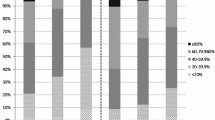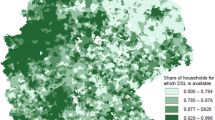Abstract
The impact of broadband access and use continues to transform the socioeconomic landscape placing this twenty-first century infrastructure at the center of current policymaking discourse. Past studies have found a relationship between infrastructure investments and economic productivity. Recent broadband-related studies, however, have focused on general availability or adoption, and do not distinguish which specific aspect of the technology is most associated with productivity. Utilizing cross-sectional county-level data from 2017 and spatial econometric models, this research looked into better understanding the impact of multiple broadband indicators on job productivity, including innovative broader measures of digital inclusion. Results indicate that broader metrics focused on adoption or digital distress had a larger positive impact on job productivity in comparison to measures focused on speed or availability. Moreover, these impacts vary across urban and rural settings. Although the relationships identified are not necessarily causal, an alternative matching technique generally supports the results. These findings suggest that the relationship between broadband and economic productivity should be viewed from a larger, more comprehensive socioeconomic perspective. Future research should focus on looking at these effects over time and assess how policies focused on specific broadband characteristics have impacted growth.

Source: Prepared by authors based on (Anselin et al. 2006)
Similar content being viewed by others
Notes
The exception to this is the single variable gathered by Microsoft, which was only available for 2018.
Alesina et al. (1999) used the following formula to calculate this index score: Ethnic = 1 − ∑i (Racei)2, where Racei denotes the share of population by race/ethnic categories.
This dataset is known to have issues when conducting spatial analysis (Grubesic and Mack 2016; Grubesic 2011). Further, recent research has shown has shown that the Form 477 data overstates actual broadband availability, with 13 percent of addresses depicted as having service subsequently failing a “self-check” by using the online availability tool of the corresponding providers (Busby and Tanberk 2020). However, it remains the most commonly used and most comprehensive source of broadband data for the USA.
A spreadsheet with county-level data (available by request) was generated from the map online by manually entering the county values. While Microsoft did not share their detailed methodology, some information alludes to this variable being calculated by server logs.
Note that this is the current speed threshold used by the FCC to define broadband.
A queen contiguity weight matrix is used for Fig. 1; alternative distance-based or 5-nearest neighbor specifications give very similar maps and overall Moran’s I measures.
We implement these tests (and resulting spatial models) in GeoDa 1.14.
These variables are: log of population, industrial diversity, percentage of population over 25 with a bachelor’s degree, and the unemployment rate.
We further note that the interpretation of each \(\theta_{1}\) and \(\theta_{2}\) will vary because the broadband measures are scaled differently (i.e., percentages in some instances, indices in others).
These four broadband variables are highlighted in the gray rows of Table 3 and represent the only significant parameters for either metro or nonmetro areas.
The L1 statistic in Table 7 measures the imbalance of the dataset, with higher values implying larger imbalance.
Only the result for 25/3 (pbbnd253) differs between Tables 6 and 7, perhaps because of the different interpretation of the coefficients. Recall that the coefficients in the spatial models are for a 1-unit increase in the percentage of residents with access to 25/3, while in the CEM regressions they are for the “treatment effect” of being in a high-access county.
References
Alesina A, Baqir R, Easterly W (1999) Public goods and ethnic divisions. Quart J Econ 114(4):1243–1284
Anselin L (1988) Lagrange multiplier test diagnostics for spatial dependence and spatial heterogeneity. Geogr Anal 20(1):1–17. https://doi.org/10.1111/j.1538-4632.1988.tb00159.x
Anselin L (2005) Exploring spatial data with GeoDa: a workbook. Center for Spatially Integrated Social Sciences, University of Illinois Urbana Champaign, Urbana
Anselin L, Bera AK (1998) Spatial dependence in linear regression models with an introduction to spatial econometrics. In: Ullah A (ed) Handbook of applied economic statistics. CRC Press, Boca Raton, pp 237–266
Anselin L, Syabri I, Kho Y (2006) GeoDa: an introduction to spatial data analysis. Geograp Anal 38:5–22
Aschauer DA (1989) Is public expenditure productive? J Monet Econ 23:177–200
Atif S, Endres J, Macdonald J (2012) Broadband infrastructure and economic growth: a panel data analysis of OECD countries. SSRN. Retrieved from https://ssrn.com/abstract=2166167. Accessed Sept 2019
Batty M, Axhausen K, Giannotti F, Pozdnoukhov A, Bazzani A, Wachowicz M, Portugali Y (2012) Smart cities of the future. Eur Phys J Spec Top 214(1):481–518. https://doi.org/10.1140/epjst/e2012-01703-3
Blackwell M, Iacus S, King G (2009) Cem: coarsened exact matching in stata. Stata J 9(4):524–546. https://doi.org/10.1177/1536867X0900900402
Briglauer W, Gugler K (2018) Go for gigabit? First evidence on economic benefits of (ultra-) fast broadband technologies in Europe. Zentrum für Europäische Wirtschaftsforschung (ZEW). (discussion papers)
Brynjolfsson E, Yang S (1996) Information technology and productivity: a review of the literature. Adv Comput 43:179–214. https://doi.org/10.1016/S0065-2458(08)60644-0
Busby J, Tanberk J (2020) FCC reports broadband unavailable to 21.3 million Americans, broadbandnow study indicates 42 million do not have access. BroadbandNow Research. Retrieved from https://broadbandnow.com/research/fcc-underestimates-unserved-by-50-percent. Accessed Sept 2019
Cingano F, Schivardi F (2004) Identifying the sources of local productivity growth. J Eur Econ Assoc 2(4):720–742. https://doi.org/10.1162/1542476041423322
Corey KE, Wilson MI (2006) Urban and regional technology planning. Taylor & Francis Inc, New York
Czernich N, Falck O, Kretschmer T, Woessmann L (2011) Broadband infrastructure and economic growth. Econ J 121(552):505–532
Deller S, Whitacre B (2019) Broadband’s relationship to rural housing values. Pap Reg Sci 98:2135–2156. https://doi.org/10.1111/pirs.12450
Dewan S, Kraemer KL (2000) Information technology and productivity: evidence from county-level data. Manag Sci. https://doi.org/10.1287/mnsc.46.4.548.12057
Duranton G, Puga D (2004) Micro-foundations of urban agglomeration economies. In: Henderson JV, Thisse JF (eds) Handbook of regional and urban economics. Elsevier, Amsterdam
Duvivier C (2019) Broadband and firm location: some answers to relevant policy and research issues using a meta-analysis. Can J Reg Sci 42(1):25–45
Elhorst P, Vega S (2013) On spatial econometric models, spillover effects, and W. 53rd Congress of the European Regional Science Association (ERSA), p. 1–28. Palermo. Retrieved from https://www.econstor.eu/handle/10419/123888. Accessed Sept 2019
Fallah BN, Partridge MD, Olfert M (2011) Urban sprawl and productivity: evidence from US metropolitan areas. Pap Reg Sci 90(3):451–472. https://doi.org/10.1111/j.1435-5957.2010.00330.x
Fifield J (2016) Despite state barriers, cities push to expand high-speed internet. Retrieved from Government Technology https://www.govtech.com/network/Despite-State-Barriers-Cities-Push-to-Expand-High-Speed-Internet.html. Accessed Sept 2019
Fogel RW (1964) Railroads and the American economic growth: essays in economic history. Johns Hopkins Press, Baltimore
Ford GS (2018) Is faster better? Quantifying the relationship between broadband speed and economic growth. Telecommun Policy 42(9):766–777
Gallardo R (2019) Digital divide index. Retrieved from Purdue Center for Regional Development http://pcrd.purdue.edu/ddi. Accessed Sept 2019
Gallardo R, Geideman C (2019) Digital distress: what is it and who does it affect. Part 1. Retrieved from Medium https://medium.com/design-and-tech-co/digital-distress-what-is-it-and-who-does-it-affect-part-1-e1214f3f209b. Accessed Sept 2019
Greenstein S, McDevitt R (2012) Measuring the broadband bonus in thirty OECD countries. OECD digital economy papers 197. Retrieved from https://ideas.repec.org/p/oec/stiaab/197-en.html. Accessed Sept 2019
Grimes A, Ren C, Stevens P (2012) The need for speed: impacts of internet connectivity on firm productivity. J Prod Anal 37:187–201
Grubesic TH (2011) The U.S. national broadband map: data limitations and implications. Telecommun Policy 36:113–126
Grubesic TH, Mack EA (2016) Broadband telecommunications and regional development. Routledge, New York
Hansen NM (1965) The structure and determinants of local public investment expenditures. Rev Econ Stat 47(2):150–162
Hauge JA, Prieger JH (2010) Demand-side programs to stimulate adoption of broadband: what works? Rev Netw Econ 9(3). https://doi.org/10.2202/1446-9022.1234
Holmgren J, Merkel A (2017) Much ado about nothing? - A meta-analysis of the relationship between infrastructure and economic growth. Research in Transportation Economics 63:13–26
Holt L, Jamison M (2009) Broadband and contributions to economic growth: lessons from the US experience. Telecommun Policy 33(10–11):575–581
Iacus SM, King G, Porro G (2012) Causal inference without balance checking: coarsened exact matching. Polit Anal 20(1):1–24
Jayakar K, Park E-A (2013) Broadband availability and employment: an analysis of county-level data from the national broadband map. J Inform Policy 3:181–200
Kelejian H, Prucha I (1998) A generalized spatial two-stage least squares procedure for estimating a spatial autoregressive model with autoregressive disturbances. J Real Estate Financ Econ 17:99–121
Kim Y, Orazem PF (2017) Broadband internet and new firm location decisions in rural areas. Am J Agric Econ 99(1):285–302
Kolko J (2012) Broadband and local growth. J Urban Econ 71(1):100–113
Koutroumpis P (2009) The economic impact of broadband on growth: a simultaneous approach. Telecommun Policy 33(9):471–485
Latif Z, Mengke Y, Danish LS, Ximei L, Pathan Z, Salam S, Jianqiu Z (2018) The dynamics of ICT, foreign direct investment, globalization and economic growth: panel estimation robust to heterogeneity and cross-sectional dependence. Telemat Inform 35:318–328
Lesage JP, Fischer MM (2008) Spatial growth regressions: model specification, estimation and interpretation. Spat Econ Anal 3(3):275–304. https://doi.org/10.1080/17421770802353758
Lobo BJ, Alam MR, Whitacre BE (2019) Broadband speed and unemployment rates: data and measurement issues. Telecommun Policy. https://doi.org/10.1016/j.telpol.2019.101829
Mack EA (2014a) Broadband and knowledge intensive firm clusters: essential link or auxiliary connection? Pap Reg Sci 93(1):3–29. https://doi.org/10.1111/j.1435-5957.2012.00461.x
Mack EA (2014b) Businesses and the need for speed: the impact of broadband speed on business presence. Telemat Inform 31(4):617–627
Mack EA, Faggian A (2013) Productivity and broadband: the human factor. Int Reg Sci Rev 36(3):392–423. https://doi.org/10.1177/0160017612471191
Mack EA, Rey SJ (2014) An econometric approach for evaluating the linkages between broadband and knowledge intensive firms. Telecommun Policy 38(1):105–118
Mahasuweerachai P, Whitacre BE, Shideler DW (2010) Does broadband access impact migration in America? Examining differences between rural and urban areas. Rev Reg Stud 40(1):5–26
Manlove J, Whitacre B (2019) An evaluation of the connected nation broadband adoption program. Telecommun Policy 43(7):101809
Matt C, Hess T, Benlian A (2015) Digital transformation strategies. Bus Inform Syst Eng 57(5):339–343. https://doi.org/10.1007/s12599-015-0401-5
Melo PC, Graham DJ, Brage-Ardao R (2013) The productivity of transport infrastructure investment: a meta-analysis of empirical evidence. Reg Sci Urban Econ 43:695–706
Microsoft (2018) An update on connecting rural America: the 2018 Microsoft Airband initiative. Retrieved from https://blogs.microsoft.com/uploads/prod/sites/5/2018/12/MSFT-Airband_InteractivePDF_Final_12.3.18.pdf. Accessed Sept 2019
Mossberger K, Tolbert CJ, Hamilton A (2012) Broadband adoption|measuring digital citizenship: mobile access and broadband. Int J Commun 6:2492–2528
Muro M, Liu S, Whiton J, Kulkarni S (2017) Digitilization and the American workforce. Brookings Institute. Retrieved from https://www.brookings.edu/research/digitalization-and-the-american-workforce/. Accessed Sept 2019
Nasr A (2019) Broadband data collection is outdated—the FCC needs to do more. Retrieved from New America https://www.newamerica.org/oti/blog/broadband-data-collection-is-outdatedthe-fcc-needs-to-do-more/. Accessed Sept 2019
Partridge MD, Rickman DS (2008) Distance from urban agglomeration economies and rural poverty. J Reg Sci 48(2):285–310. https://doi.org/10.1111/j.1467-9787.2008.00552.x
Pradhan R, Arvin M, Nair M, Mittal J, Norman N (2017) Telecommunications Infrastructure and Usage and the FDI-growth Nexus: evidence from Asian-21 countries. Inform Technol Dev 23:235–260
Romer P (1990) Endogenous technological change. J Polit Econ 98:71–100
Venables AJ (2007) Evaluating urban transport improvements: cost-benefit analytics in the presence of agglomeration and income taxation. J Transp Econ Policy 41(2):173–188
Whitacre B, Rhinesmith C (2016) Broadband un-adopters. Telecommun Policy 40(1):1–13
Whitacre B, Gallardo R, Stover S (2014a) Broadband’s contribution to economic growth in rural areas: moving towards a causal relationship. Telecommun Policy 38(11):1011–1023
Whitacre B, Gallardo R, Strover S (2014b) Does rural broadband impact jobs and income? Evidence from spatial and first-differenced regressions. Ann Reg Sci 53(3):649–670. https://doi.org/10.1007/s00168-014-0637-x
YourEconomy (2020) Establishment size—percentage of total jobs (2015–2019). Retrieved from YourEconomy https://youreconomy.org. Accessed Sept 2019
Author information
Authors and Affiliations
Corresponding author
Additional information
Publisher's Note
Springer Nature remains neutral with regard to jurisdictional claims in published maps and institutional affiliations.
Rights and permissions
About this article
Cite this article
Gallardo, R., Whitacre, B., Kumar, I. et al. Broadband metrics and job productivity: a look at county-level data. Ann Reg Sci 66, 161–184 (2021). https://doi.org/10.1007/s00168-020-01015-0
Received:
Accepted:
Published:
Issue Date:
DOI: https://doi.org/10.1007/s00168-020-01015-0




